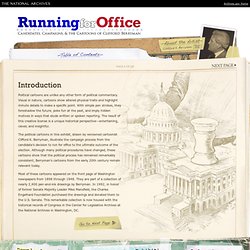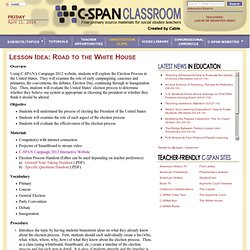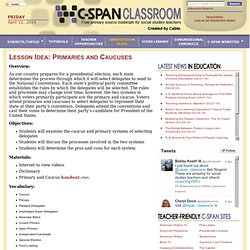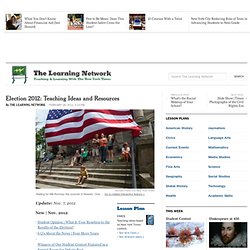

iSideWith.com. The Living Room Candidate. PCL: Campaign 2012: Presidential Election Ads. Where a Bill Becomes a Law : S. 773, 111th Congress. If You Were President. Running for Office - Cartoons of Clifford K. Berryman. Clifford K.

Berryman: Political Cartoonist Extraordinaire In 1886 at the age of 17, Clifford K. Berryman moved from Kentucky to Washington, DC, to work at the U.S. Patent Office, where he used his self-taught talents to draw patent illustrations. He left the Patent Office in 1891 to become a cartoonist’s understudy for the Washington Post.
Washington political circles embraced Berryman’s cartooning. Berryman is most celebrated for his November 16, 1902, Washington Post cartoon, “Drawing the Line in Mississippi,” which portrayed an image of the teddy bear for the first time. Featured Lesson Idea: Road to the White House. Overview Using C-SPAN’s Campaign 2012 website, students will explore the Election Process in the United States.

They will examine the role of early campaigning, caucuses and primaries, the conventions, the debates, Election Day, continuing through to Inauguration Day. Then, students will evaluate the United States’ election process to determine whether they believe our system is appropriate in choosing the president or whether they think it should be altered. Objective Students will understand the process of electing the President of the United States Students will examine the role of each aspect of the election process Students will evaluate the effectiveness of the election process Materials Computer(s) with internet connection Projector of SmartBoard to stream video C-SPAN Campaign 2012 Interactive Website Election Process Handout (Either can be used depending on teacher preference) a) General Note Taking Handout (.PDF) b) Specific Questions Handout (.PDF) Vocabulary Procedure. Featured Lesson Idea: Presidential Candidate Research.
Overview Using C-SPAN’s Video Library and Congressional Chronicle, students will research and evaluate candidates for any election based on their positions on key policy issues.

Through watching clips of candidate speeches, students will determine the candidates’ position on the economy, foreign policy, health care, immigration, and more. Then, students will compare and contrast the candidates’ views with their own views. Objective Students will identify and research candidates’ positions on key policy issues. Materials Vocabulary Policy Platform Taxes Economy Foreign Policy Health Care Immigration Energy/Environment Procedure 1. Free Lesson Plans and Games for Learning Civics. Featured Lesson Idea: Primaries and Caucuses. Overview: As our country prepares for a presidential election, each state determines the process through which it will select delegates to send to the National Conventions.

Each state’s political party committee establishes the rules by which the delegates will be selected. The rules and processes may change over time; however, the two systems in which voters primarily participate are the primary and caucus. Voters attend primaries and caucuses to select delegates to represent their state at their party’s convention. Delegates attend the conventions and cast their votes to determine their party’s candidate for President of the United States. Objectives: Students will examine the caucus and primary systems of selecting delegates Students will discuss the processes involved in the two systems Students will determine the pros and cons for each system Materials: Internet to view videos Dictionary Primary and Caucus handout (.PDF) Vocabulary: Introduction: Procedure: 1. Congress for Kids - Interactive, Fun-filled Experiences About the Federal Government.
Election 2012: Teaching Ideas and Resources. Update: Nov. 7, 2012 New | Nov. 2012 New | Oct, 2012 New | Sept. 2012 Here are some suggestions for teaching and learning about the 2012 election season, followed by selected New York Times features and Learning Network lesson plans.

Bookmark this page: we’ll be adding activity ideas and resources as the march to the White House proceeds, and will link from here to all the election resources we publish. Meanwhile, we’d love to hear from you! Our Election 2012 Unit We’ve designed our Election 2012 Unit to put teenagers front and center of this election. Mini-Unit 1: Who are the candidates? Students research one candidate and retool his campaign to appeal to younger voters by creating brochures, slide shows, biographies or Facebook pages or other social media strategies to introduce him. Mini-Unit 2: What are the issues? Www.democracykids.org/demo_kids_1/main.swf.